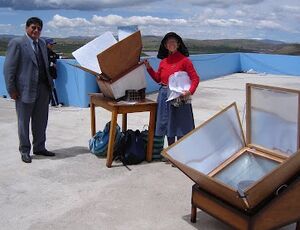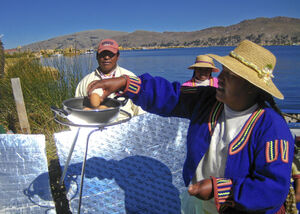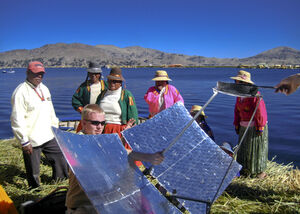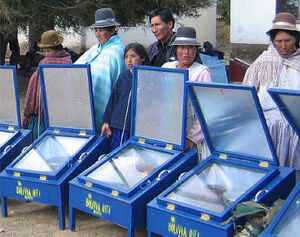Most significant projects
- Bolivia Inti-Sud Soleil reports a decade of success - Bolivia Inti-Sud Soleil reports they have distributed more than 20,000 ecological appliances since 2000. From these 20,000, 14,000 have been solar cookers, mainly distributed in the South American countries of Peru, Bolivia, Chile, and Argentina. Additionally, 5,000 Rocket Stoves were distributed in the African countries of Benin, Chad, and Guinea, as well as to the South American countries. Besides solar cookers and stoves, they have also provided fireless cookers, solar food dryers and solar showers. On November 5, 2011, the organization is sponsoring a national conference addressing deforestation in Africa to be held in their hometown of Nantes, France.
Events
News and Recent Developments

Tara Miller demonstrates the solar cookers to a government official in Feb. 2012.
- February 2012: At the invitation of the Munincipalidad de El Collao, Ilave, Tara Miller and Sam Brown gave a solar cooking demonstration to a gathering of over 200 government officials from the area. They used a ULOG cooker newly made in Puno and an older four reflector panel cooker we had made in 1997 on Taquile Island. We cooked yams in both cookers in partly cloudy conditions. Tara mentioned, there were 300 printed copies of our cooker building instructions available, and they ran out. Read more...
- August 2010: Project News: Bolivia - Peru Solar Cook Stoves - actioncarbone.org

Residents try cooking with the new oven provided by the Brigham Young University student project

Brigham Young University student project.
- May 2010: Nineteen Brigham Young University student engineers traveled to Peru’s fabled high mountain Lake Titicaca to deliver a special solar oven as part of their course on sustainable engineering projects that help improve local people’s standard of living. The students worked with the people of the Uros islands. The islands are constructed from floating beds of reeds and soil about nine feet thick, anchored to the lakebed with boulders. Power is difficult to come by, so the Uros cook fish, fowl and homegrown potatoes with expensive propane stoves or time-consuming, reed-fed fires. Local residents were intrigued by the new approach to cooking. More Information...
- November 2008: In late 2006, Acciónatura, a Spanish NGO, approached Solar Household Energy (SHE) about implementing a project in Peru with their Peruvian partner NGO. While they had the funding to buy the HotPots and implement the project, they did not have the solar cooking technical expertise. Therefore, they requested in-country technical solar cooking support from Solar Household Energy (SHE). SHE signed a Terms of Reference with Acciónatura to work in a consortium with Asociación de Ecosistemas Andinos (ECOAN) to conduct a solar cooking project. The solar cooking trainings were launched in mid-April outside of Lucre, Peru (about 30 kilometers from Cuzco). During five separate trainings, 100 women learned solar cooking techniques. Traditional Peruvian dishes, estofada (chicken and potato stew), rice, and baked peaches were cooked. All the women were extremely impressed with the ability of the HotPot to cook traditional food. In the coming months, the women will attend follow-up meetings where they will share solar cooking experiences. Additionally, the women will participate in a work-exchange program. In the work-exchange program, the women will plant trees in a reforestation project, conduct solar cooking demonstrations in their communities, and conduct solar cooking demonstrations at a regional food fair.
- February 2007: Rotarians help Peruvians learn solar cooking
The History of Solar Cooking in Peru
Two staff members of the Centro de la Familia Anna Dengel in Arequipa, Peru undertook a pilot project early in the 1990s. The project included both a pilot and an implementation stage. In the pilot part, they considered a range of cooker designs, and settled on a box cooker of cardboard. After that decision, an implementation process involved the construction of 30 cookers by persons who were also trained in cooking methods. All 30 persons were able to complete the construction process successfully.
Next, 24 people were trained in use of the cooker; 80% or 19 family cooks successfully used the boxes they had made. With that project behind them, the two promoters began to seek additional resources to expand their efforts. To the best of our knowledge, they were not successful in locating funds for a larger effort.
Currently, each is however working separately to promote cookers. Sister Patricia Gootee continues to make and sell a small number of cookers, and Geovana Rivera also teaches solar cooking, and designs and builds new types of cookers.
More recently, a Center of Renewable Energy has been created in Lima. Its work includes design, research, and construction of several models of solar cookers. In addition, Jorge Armando Choque Chacolla, of the Centro Poblado Menor in Tacna, an Andean area, is also working to spread solar cooking in mountainous areas.
[Information for this section was taken originally from State of the Art of Solar Cooking by Dr. Barbara Knudson]
Climate, Culture, and Special Considerations
Resources
Possible funders for solar cooking projects in Peru
- Asociación Arariwa
- FINCA Peru
- Microfinanzas Prisma
- Manuela Ramos / CrediMUJER
- Edpyme Alternativa
- Caja Rural Señor de Luren
Reports
Blogs
Articles in the media
- February 2007: Rotarians help Peruvians learn solar cooking
Web pages
- Preguntas Frecuentes de la Cocción Solar
- Peru Children’s Trust page on solar cooking (También en español).
Grupo de discusión Facebook
Audio and video
Contacts
The entities listed below are either based in Peru, or have established solar cooking projects there:
SCI Associates
- Main article: Solar Cookers International Association

